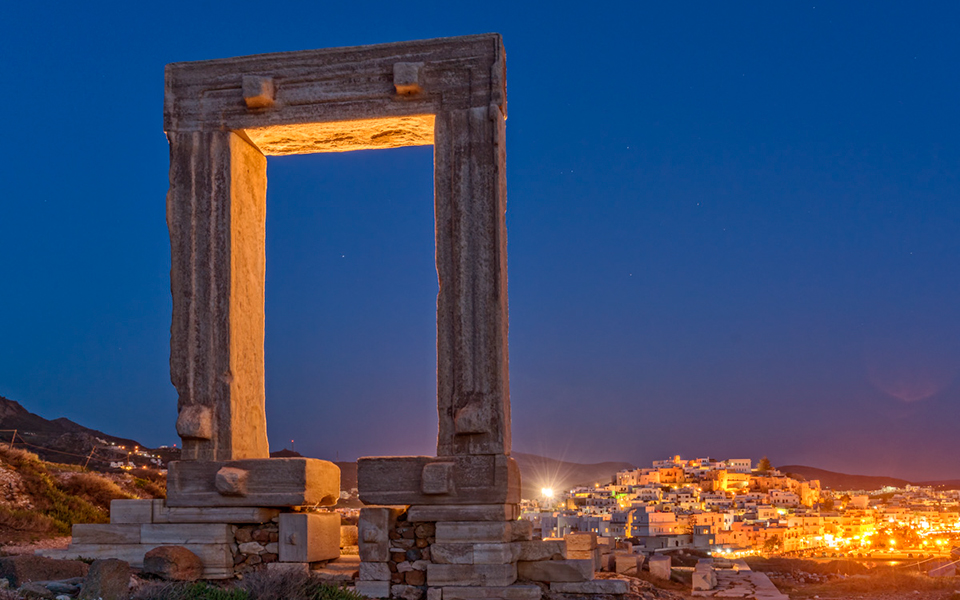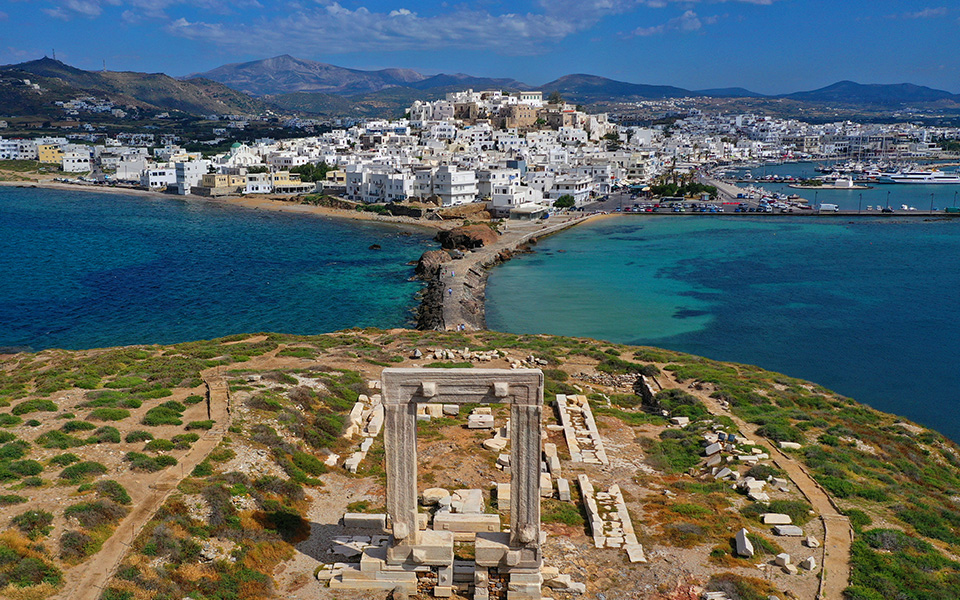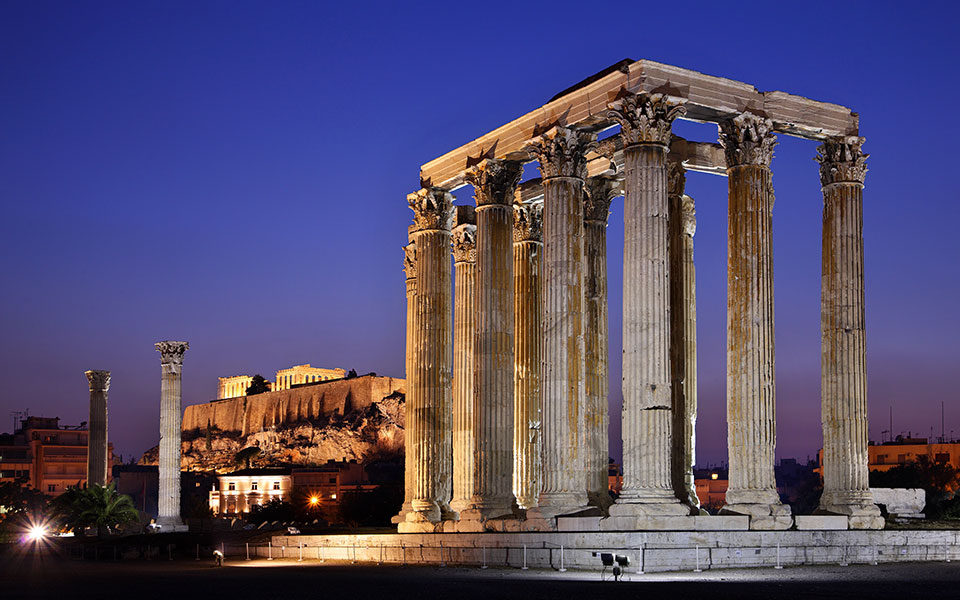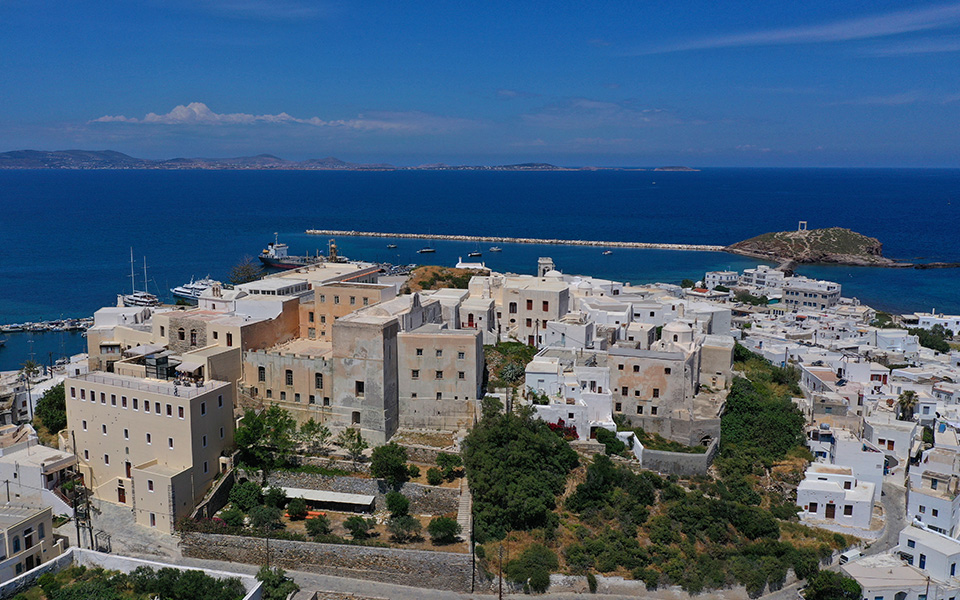Standing guard at the entranceway to Naxos harbor, bearing silent witness to the comings and goings of countless visitors to the island for over two and a half millennia, the colossal marble doorway known as the “Portara” is something of an enigma; a giant doorway to nowhere.
The iconic landmark located at the heart of Cyclades, instantly recognizable and emblematic of Naxos, has intrigued travelers and historians for centuries, curious to learn more about its origins and purpose. Glistening white against the piercing Mediterranean sky, it’s no surprise that the Portara, which means “Great Door,” has become one of Greece’s most photographed monuments.
But what do we really know about this mysterious monument? Is it merely the partial remains of a once glorious ancient temple? Or is there something more to the story?

© Perikles Merakos
Dedicated to which god?
Located on the tiny islet of Palatia, connected to the Old Town (Hora) of Naxos by a narrow causeway, and commanding spectacular views of the surrounding seascape, archaeologists agree that the colossal marble doorway is the remnants of a gigantic unfinished temple, dated to the last quarter of the 6th century BC. Crafted from local white marble quarried from Apollonas, at the north end of the island, the towering edifice measures 6m in height and 3.5m in width, with a thickness of 1.3m. Consisting of four separate lintels, each weighing approximately 20 tons, the doorway was intended to serve as the main entrance to the imposing temple.
Archaeologists also agree that the temple was started by the tyrant Lygdamis of Naxos, who ruled the island from c. 540 to 506 BC, but his ambitious building project was never finished, leaving only part of its monumental doorway and the foundations of the inner cella. If completed, the temple would have been 59m long and 28m wide, with a peristyle of 6×12 columns, rivalling in size and splendour the biggest temples in the ancient Greek world.
What they can’t agree on, however, is whether the temple was intended to be a place of worship for Apollo, god of music, poetry, and the Sun, or Dionysus, god of wine and revelry. Those arguing in favor of Apollo note the orientation of the Portara, which faces in the direction of the nearby sacred isle of Delos, the god’s fabled birthplace. Today, most people refer to the Portara as the intended site of a temple dedicated to Apollo, but not everyone agrees.
After all, Dionysus was regarded as a popular local deity by the island’s ancient inhabitants, akin to a patron god. According to Greek mythology, Dionysus emerged from Zeus’ thigh on Naxos, and was entrusted to three local nymphs, Filia, Cleidi, and Koroni, who nurtured and raised him. In turn, Dionysus used his divine power to bestow the island with rich vineyards and fertile soil, making it wealthy and prosperous.
Another important myth linking Dionysus to Naxos can be traced back to the story of Theseus, the mythical hero of Athens, who abandoned Ariadne, the daughter of king Minos of Crete, on the islet of Palatia – the precise location of the Portara – after she had helped him defeat the bull-headed Minotaur. Taking pity on her, Dionysus made Ariadne his wife and gave her a crown of seven stars, which became a constellation, the Corona Borealis, after her death.

© Shutterstock
The rise of a tyrant
During the 8th and 7th centuries, Naxos emerged as one of the most powerful commercial centers in the Cyclades, dominating maritime trade routes between the neighboring islands and across the Aegean. Naxian marble, known for its exceptional quality and large grain crystals, was one of its most sought-after exports, gathering huge wealth for the islanders. Regarded as one of the first types of Cycladic “island marbles,” Naxian marble was used in the manufacture of some of ancient Greece’s most iconic statues and monuments, and is still widely exported today.
As the island accrued more and more wealth, an oligarchic regime was established sometime in the 6th century BC, concentrating all the power and wealth in the hands of a small number of Naxian elites. The most famous of these was Lygdamis, who helped the infamous tyrant Peisistratos seize power in Athens in 546 BC. In return, Peisistratos supported Lygdamis in his plans to take total control of Naxos, and the pair became close allies. To secure his position, Lygdamis promptly exiled potential rivals from the island and extended his authority over neighboring polities, including Paros.
To further boost his power and influence in the wider Aegean region, Lygdamis assisted other like-minded autocrats, sending a force of mercenaries in support of Polykrates, tyrant of Samos, in his campaigns against Miletus, a city-state on the coast of Asia Minor, and Mytiline (Lesvos).

© Shutterstock
Unfinished ambition
Throughout antiquity, monumental architecture was often used as a means to project political power, designed to humble the viewer to an idea or instil a sense of collective identity. Indeed, no ancient Greek tyrant worth his salt ignored the potential of an ambitious building program to legitimize power, something that Lygdamis embraced with gusto.
His grand idea was to build a temple to rival the size and grandeur of any in the ancient Greek world, including the famous Temple of Hera on Samos, the first of the gigantic free-standing Ionic temples (a UNESCO World Heritage Site), and the Temple of Olympian Zeus in Athens, which had began construction in 520 BC under the tyrants Hippias and Hipparchos, the sons of Peisistratos.
Launched as the ultimate testament to the Lygdamis’ power and wealth, the reason why the temple was never completed remains shrouded in mystery. One prevailing theory suggests that he was overthrown before the temple could be finished. With his downfall, the funds and resources necessary to complete the project vanished, leaving behind only the monumental doorway that we see today.
Another theory posits that Lygdamis simply died, and his successor thought it an act of hubris to build on such scale, in much the same way democratic Athenians left the Temple of Olympian Zeus unfinished for over 300 years.

© Shutterstock
Where did all the marble go?
During the Middle Ages, the area of the temple’s foundations was picked apart for marble and other construction materials, for use in newer buildings. In the aftermath of the Fourth Crusade, the Venetians conquered the island and recycled some of the material for the Kastro (castle), built in 1207 over the remains of the ancient acropolis.
Today, visitors strolling through the picturesque alleyways of old Hora can catch glimpses of dressed marble set into the historic buildings, stones that were likely recycled from the site of the ancient temple.
As for the Portara, whether bathed in the golden light of sunrise or illuminated by the soft glow of the moon, the colossal doorway casts a spell over all who behold it. Despite its unfinished state, the Portara has transcended its original purpose to become the island’s most iconic attraction.












